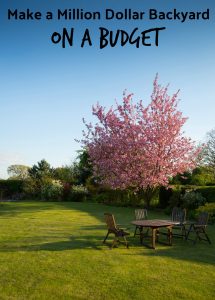We all know it’s true: having an Insta-worthy garden is the source of so much happiness. Every homeowner dreams of how to make a million-dollar backyard on a budget.
RELATED POST: Beautiful Backyard Ideas to Make Everything Prettier

It’s that tonic for tired eyes when you walk down the stairs first thing in the morning. You stare out of the kitchen window as you wait for the kettle to boil. It’s sitting on your deck in the late afternoon, a glass of cool white wine sat comfortably in your hand and the scent of freshly cut lawn filling your nostrils. It’s that place to walk your dog before the sun finally drops below the horizon. There, you entertain your guests when it’s your turn to barbecue. Moreover, it’s that place your kids can escape to, desperate to make their imaginations dance and jive. It all comes from a landscape that looks like a million dollars.
The problem is: none of us really wants to spend that much money (or has that much money to spend) on their garden. It’s one of life’s great pains. But it doesn’t have to be. Nope. Not at all. In fact, you can get a million-dollar garden without spending much more than a handful of dollars.
Read on to see our top tips and tricks to save some mega-money when it comes to sprucing up your backyard:

Say Bye Bye to Those Slugs That Damage Your Backyard
Slugs are one of the worst. It’s not just because they look gross and leave those silvery trails everywhere. But because they have 14,000 teeth that will just eat, eat and eat some more. But no need to fork out a ton of money for slug killers or special slug traps. Because there are some much simpler hacks to deploy. If slugs attack your potting plants, just pop some Vaseline at the base and top of your pots and watch those slugs slip off. If you want to get rid of slug slime and stop them coming back, make a little vinegar spray. You could even sprinkle some salt around your beds to deter those little suckers.
Save On Seed Trays
Seed trays can quickly add up to an eye-watering amount (don’t believe us, just check your bank statements). You should instead use fruit punnets and egg cartons (empty ones obviously). Because these are absolutely ideal for planting little seedlings. Egg cartons are absolutely perfect for two reasons. a) they have separate sections and b) loads of them are made from recycled paper. This means you can just pop them in the ground when the seedlings are ready for the big, bad world. Give it three weeks and your egg carton will have decomposed too, making the transfer part of the process so-so simple.
DIY Sprinkler Systems
We’re not sure if you’ve walked down the hosepipe aisle of your local home improvement store recently, but sprinkler systems have really crept up on the price front in recent months. Thankfully, you don’t need to be spending your money on any lavish sprinkler systems. All you need to do is recycle an old hosepipe by punching in a small hole every thirty centimeters or so and then wind it through your flower beds. Not only will that help you save on your water bill, it will also help you save big time upfront because all you have to do is connect to your outside tap, and turn it on and off when you see fit. It’s so easy and so cheap.
Don’t Overplant Your Bits
We all garden with the endgame in mind. It’s part of the excitement. It’s knowing these little trees and shrubs and plants and whatnot will grow into something huge and beautiful as the months and years roll on. But that’s also why you need to plant with a bit of foresight and plan your landscape with mature sizes in mind. If you don’t, well, you’ll probably end up paying the price when you have to dig them up and move them (by which we mean: pay someone a hefty chunk of change to do this for you).
Perform A Soil Test
A soil test is about as simple as anything can be, but it’s also super useful as it will tell you exactly what your soil lacks. The reason this is useful is simple: you won’t end up buying unneeded additives, the wrong fertilizers or plants that will struggle to grow from what you have. This is because most soil tests these days also recommend the best plant options for your soil type, meaning you can grow a carefree garden without trying to amend your ground. Winner-winner, chicken dinner.
Leave Those Clippings in the Backyard, Don’t Rake Them
Of course, there is an exception to every rule and, on this occasion, it’s to do with thatch. If your lawn seems to be stupidly susceptible to thatch, then it’s a good idea to collect your clippings. However, for every other lawn, it’s a great idea to mulch your clippings back into your lawn. This is because grass clippings tend to break down pretty quickly, giving your grassroots the sort of organic matter and nutrients they need to thrive. Basically, mulched grass clippings are the same as fertilizer; the big difference being, they’re free. Check that out.

Always, Always Cut High
We’re talking about three inches, maybe even three and a half. That’s the height you should be setting your mower’s deck at. We know that’s a little bit like having a shag pile rug for a lawn, but it’s the length most grass thrives at best. But that’s not all. Aesthetically speaking, it’s better to have a lush and longish lawn than to have a short brownish one. Surely. Anyway, the higher you let your grass blades grow, the deeper the root system will be, which is good news for your bank balance because you won’t have to water it as often. What’s more, tall grass also shades out weeds better so you won’t have to spend money on herbicides either.
And there we have it. Your essential guide to making a million dollar backyard without spending much at all. It’s all within your reach.

